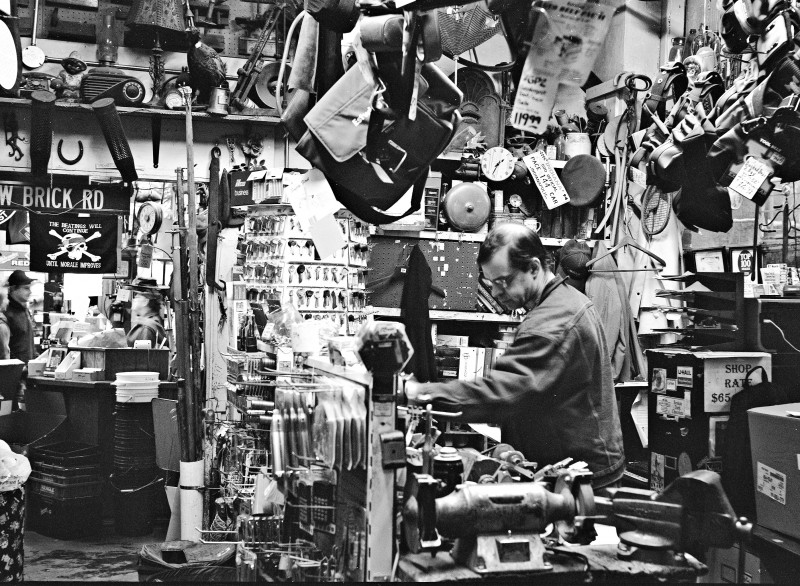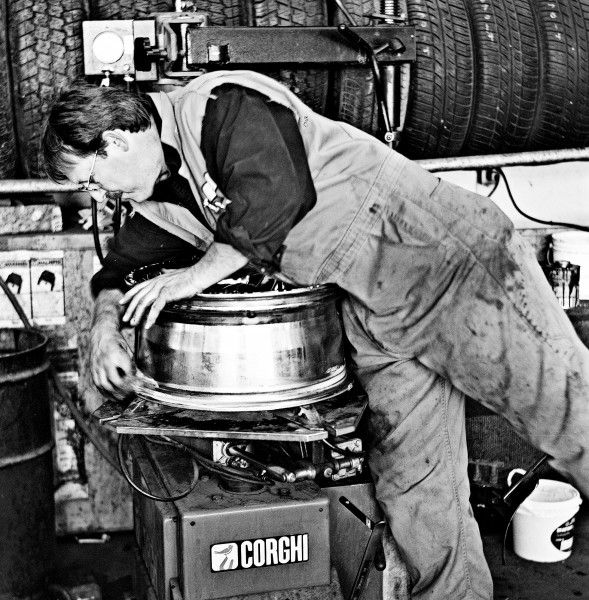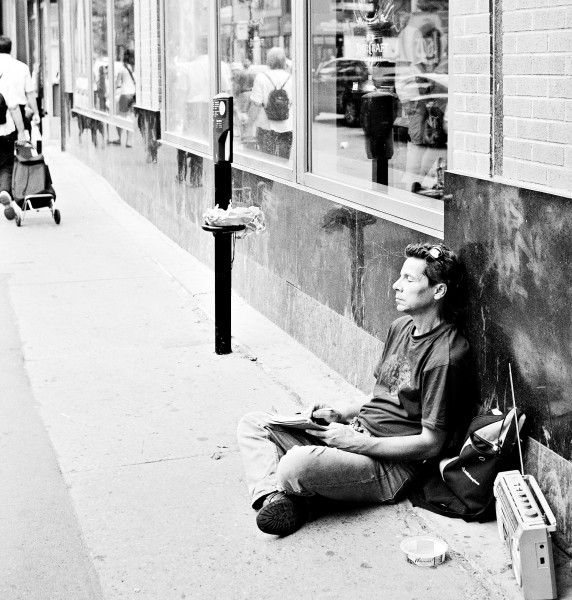
Cutting Keys at Hardwick’s
Clearly, this is not Home Depot. Welcome to one of my favourite haunts: Hardwick’s Hardware in Seattle. Want a reverse-bladed Japanese saw? A fine set of wood turning tools? Brass corners for an ornamental box? Endless numbers of delicate wood carving tools? Racks of pliers with smooth points, long points, duckbill jaws, round jaws? If you have specialized hardware needs, from tiny 00 brass wood screws to a fine pocket knife, Hardwick’s has it.
Any photo of Hardwick’s is a study in complexity. Classicaly, one aims for a clean, dramatic image that highlights the subject. This image breaks those rules; the young key cutter is almost lost in Hardwick’s clutter that fills the cases and tabletops, then climbs up the walls. It takes some visual concentration to separate the young assistant from his surroundings. Many would say this picture is too complicated and busy. Obviously, I have an emotional connection to Hardwick’s, but to me that’s the point of the image: the delightful, glorious, overwhelming clutter of the place.
Taken on my favourite street photography camera, the Ensign 820 in 6×9 cm. format, masks folded back, steadied on a table top and near the maximum aperture of the f/3.5 Ross Xpres lens, using Ilford XP-2 at around 1/25 second.
Modern Note:
Two years later, I returned to Hardwick’s and took the following image as a short cell phone panorama from almost the same spot completely undetected: A Fascinating Comment on Hardwick’s:
A Fascinating Comment on Hardwick’s:
A wonderful review that I found about Hardwick’s:
“…Clueless one-star reviewers:
If you believe “the customer is always right,” you’re probably exactly the kind of self-impressionable young dewdlet who will have your ego handed to you by the staff at Hardwick’s, julienne-sliced and neatly arranged on a second-hand (but only slightly chipped) serving platter. If you charge through the doors in a flaming hurry, you might well become a bit frustrated by the fact that nobody wears a uniform smock in a friendly, primary color with a tag that lets you address them by their first name without introductions — or that, when you do find a staffer, he or she isn’t going to cut short the $0.86 transaction with the old gal who just needs a couple of picture hangers, even though you’re OBVIOUSLY tapping your foot and waiting impatiently for that batt of insulation that they don’t carry.
Look, it’s not a home center, and it’s not all about you. Once described as “a finishing school for grumpy old men,” Hardwick’s hires employees who are more like tour guides than clerks. There’s a strong chance that not only do they know what you want and where it is, but can talk you through four or five different ways to go about your project — and show you which parts and tools (all of which they stock) can be used to complete it. Keep going back for 20 or 30 years — like ten thousand diehard customers before you — and Hardwick’s will change your life.
But if you march in there with a chip on your shoulder, they’ve definitely got the tools to cut you down to size. They were there before you blew into town, and they’ll be there after you’re dead. Besides, it’s part of the compensation package: nobody makes much money at Hardwick’s, but management allows their staff to offer real service WITHOUT subservience.
Be grateful for that. They’re teaching you what your parents should have taught you, years before you were blessed to walk through the doors of Hardwick’s: enough humility to get out of your own way and build something beautiful. Check your ego (and your backpack) at the door, take the tour, and have your eyes opened. Those grubby people ghosting around the aisles include boatbuilders, artists, Burners, millwrights, cabinetmakers, and the world’s most renowned antique motorcycle restorer. If it’s good enough for them…
Anyone can walk into Lowe’s and leave with a Kobalt Chinese spade and a cheap Stanley hammer. Go to Hardwick’s instead, and learn about hori-horis, hard-forged North Bay drawknives, laminated white steel pruners, and seventeen models of framing hammers. Like moving from Southern Comfort to single malt Scotch, going to a real hardware store instead of a hand-holding “home center” requires the development of an adult palate.
Hardwick’s isn’t there to make your life easier. It’s there to make Seattleites’ lives better. You either get it or you don’t. It may take more than one visit, and it will certainly require taking your time.”
Author: Jack L.
References:
Hardwick’s web site. “Rust and Dust since 1932.” http://www.ehardwicks.com/
Yelp Review. “Hardwick’s.” http://www.yelp.com/biz/hardwicks-seattle

